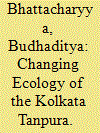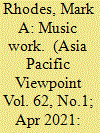| Srl | Item |
| 1 |
ID:
188751


|
|
|
|
|
| Summary/Abstract |
The tanpura, a long-necked, unfretted, stringed lute, is arguably one of the most important instruments used by Hindustani classical vocalists. This ethnographic study draws from the lived experiences of luthiers and farmers specialising in crafting tanpuras. Auto-ethnographic reflections as a vocalist of this tradition also feed into this piece. Studying the effects of various phenomena, including evolving agricultural and climatic conditions in gourd fields and increasing scarcity of raw materials, the article underlines how it affects the sonic and visual profile of the instrument, thereby gradually transforming Hindustani classical sound at a very fundamental level.
|
|
|
|
|
|
|
|
|
|
|
|
|
|
|
|
| 2 |
ID:
178460


|
|
|
|
|
| Summary/Abstract |
Recent scholarship has opened questions as to the everyday actions of the Khmer Rouge and those living under the regime which led to the Cambodian Genocide. Current work examines the critical cultural geographies of the Khmer Rouge: photography, poetry and music, for example. Music specifically has an interesting underpinning, as it was previously understood to be have been eradicated in the genocide as the standard narrative has us believe. This paper instead investigates the pieces of evidence that exist, which explain the use of music by the Khmer Rouge. I explore the geographies of music beyond the lyrics and look at the transformation and use of music in Cambodia and Democratic Kampuchea. What elements of traditional Khmer music were used during the regime? What modifications occurred to the music of Cambodia during the regime, and how did the Khmer Rouge modify existing Cambodian (and other) music to best fit their desired uses (state-building and genocide)? This paper goes beyond traditional geographies of music, which rely on lyrical analyses, to bring an ethnomusicological perspective to the work of music and its role in shaping the idea of the Democratic Republic of Kampuchea.
|
|
|
|
|
|
|
|
|
|
|
|
|
|
|
|